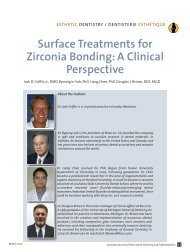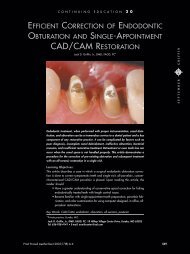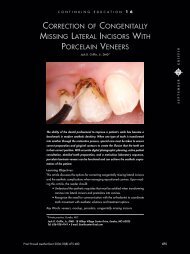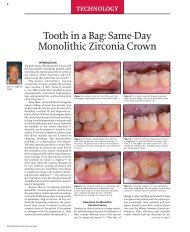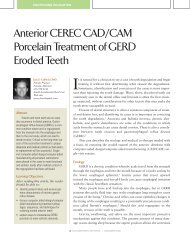Conservative Zirconia Bridge for Anterior Tooth Replacement
Conservative Zirconia Bridge for Anterior Tooth Replacement
Conservative Zirconia Bridge for Anterior Tooth Replacement
Create successful ePaper yourself
Turn your PDF publications into a flip-book with our unique Google optimized e-Paper software.
5<br />
AESTHETICS<br />
<strong>Conservative</strong> <strong>Zirconia</strong> <strong>Bridge</strong>...<br />
continued from page 00<br />
clear vacuum-<strong>for</strong>med 2 mm hard/soft<br />
nocturnal bruxism splint was made<br />
(Erkodent [Glidewell Laboratories]),<br />
and the patient was encouraged to<br />
wear it nightly and daily when grinding/clenching<br />
was noticed.<br />
Follow-up and Evaluation<br />
The soft-tissue response at 16 months<br />
was excellent with good papilla support<br />
and a natural emergence profile.<br />
After almost 2 years, there have been<br />
no clinical problems and the patient is<br />
very happy with the results (Figure 19).<br />
She felt very com<strong>for</strong>table with “the fit”<br />
and stated she had been flossing under<br />
it almost every night and had been<br />
wearing the bruxism splint regularly.<br />
SUMMARY<br />
The demand <strong>for</strong> metal-free restorations<br />
coupled with the desire <strong>for</strong> conservation<br />
of tooth structure has put<br />
new demands on our profession.<br />
There is a symbiotic synergy among<br />
the great skills of our ceramists, the<br />
commitment to successful chemistry<br />
of our researchers and manufacturers,<br />
and the unwavering desire <strong>for</strong> happy<br />
patients and long lasting restorations<br />
by clinicians (Figure 20). With continually<br />
improving bonding materials<br />
and when tooth preparation and<br />
occlusion are well planned, conservative<br />
anterior bridges should be considered<br />
in many partially edentulous<br />
cases (Figure 21). This treatment op -<br />
tion was particularly appropriate in<br />
the case described in this article,<br />
where an impacted cuspid limited the<br />
choices of treatment and the desire <strong>for</strong><br />
conservative dentistry was maintained.(Figure<br />
22).✦<br />
Acknowledgement<br />
The author wishes to thank Erik<br />
Haupt of Haupt Dental Lab, Brea,<br />
Calif, <strong>for</strong> his excellent cosmetic work<br />
and understanding of the principles<br />
of smile design.<br />
References<br />
1. Rossmann JA, Cobb CM. Lasers in periodontal<br />
therapy. Periodontol 2000. 1995;9:150-164.<br />
2. Tipton PA. Aesthetic tooth alignment using<br />
etched porcelain restorations. Pract Proced<br />
Aesthet Dent. 2001;13:551-555.<br />
3. Dumfahrt H. Porcelain laminate veneers. A retrospective<br />
evaluation after 1 to 10 years of service:<br />
Part 1—Clinical procedure. Int J Prosthodont.<br />
1999;12:505-513.<br />
4. Christensen GJ. The ceramic crown dilemma. J<br />
Am Dent Assoc. 2010;141:1019-1022.<br />
5. Quinn GD, Studart AR, Hebert C, et al. Fatigue of<br />
zirconia and dental bridge geometry: Design<br />
implications. Dent Mater. 2010;26:1133-1136.<br />
6. Fischer H, Weber M, Marx R. Lifetime prediction<br />
of all-ceramic bridges by computational methods.<br />
J Dent Res. 2003;82:238-242.<br />
7. Quinn JB, Cheng D, Rusin R, et al. Fractographic<br />
analysis and material properties of a dental zirconia.<br />
Presented at: IADR/AADR/CADR 83rd<br />
General Session; March 9-12, 2005; Baltimore,<br />
MD.<br />
8. Burke FJ, Ali A, Palin WM. <strong>Zirconia</strong>-based allceramic<br />
crowns and bridges: three case reports.<br />
Dent Update. 2006;33:401-410.<br />
9. Kugel G, Perry RD, Aboushala A. Restoring anterior<br />
maxillary dentition using alumina- and zirconia-based<br />
CAD/CAM restorations. Compend<br />
Contin Educ Dent. 2003;24:569-576.<br />
10.Rosentritt M, Ries S, Kolbeck C, et al. Fracture<br />
characteristics of anterior resin-bonded zirconiafixed<br />
partial dentures. Clin Oral Investig.<br />
2009;13:453-457.<br />
11.Beuer F, Stimmelmayr M, Gernet W, et al.<br />
Prospective study of zirconia-based restorations:<br />
3-year clinical results. Quintessence Int.<br />
2010;41:631-637.<br />
12.Guess PC, Zavanelli RA, Silva NR, et al. Monolithic<br />
CAD/CAM lithium disilicate versus veneered Y-TZP<br />
crowns: comparison of failure modes and reliability<br />
after fatigue. Int J Prosthodont. 2010;23:434-442.<br />
13.Blatz MB, Sadan A, Kern M. Resin-ceramic bonding:<br />
a review of the literature. J Prosthet Dent.<br />
2003;89:268-274.<br />
14.Dérand P, Dérand T. Bond strength of luting cements<br />
to zirconium oxide ceramics. Int J Prosthodont.<br />
2000;13:131-135.<br />
15.Denry I, Kelly JR. State of the art of zirconia <strong>for</strong><br />
dental applications. Dent Mater. 2008;24:299-<br />
307.<br />
16.Conrad HJ, Seong WJ, Pesun IJ. Current ceramic<br />
materials and systems with clinical recommendations:<br />
a systematic review. J Prosthet Dent.<br />
2007;98:389-404.<br />
17.Ozcan M, Nijhuis H, Valandro LF. Effect of various<br />
surface conditioning methods on the adhesion of<br />
dual-cure resin cement with MDP functional<br />
monomer to zirconia after thermal aging. Dent<br />
Mater J. 2008;27:99-104.<br />
18.Wegner SM, Kern M. Long-term resin bond strength<br />
to zirconia ceramic. J Adhes Dent. 2000;2:139-<br />
147.<br />
19.Kern M, Barloi A, Yang B. Surface conditioning<br />
influences zirconia ceramic bonding. J Dent Res.<br />
2009;88:817-822.<br />
20.Ernst CP, Cohnen U, Stender E, et al. In vitro retentive<br />
strength of zirconium oxide ceramic crowns<br />
using different luting agents. J Prosthet Dent.<br />
2005;93:551-558.<br />
21.Quinn F, Gratton DR, McConnell RJ. The per<strong>for</strong>mance<br />
of conventional, fixed bridgework, retained<br />
by partial coverage crowns. J Ir Dent Assoc.<br />
1995;41:6-9.<br />
22.Foster LV. The relationship between failure and<br />
design in conventional bridgework from general<br />
dental practice. J Oral Rehabil. 1991;18:491-<br />
495.<br />
23.Kristallis TT, Phimmasone A. A zirconia-based<br />
long span restoration used in restoring anterior<br />
esthetics with minor orthodontic correction.<br />
Contemporary Esthetics. November 2006:2-7.<br />
24.Matinlinna JP, Lassila LV, Vallittu PK. Pilot evaluation<br />
of resin composite cement adhesion to zirconia<br />
using a novel silane system. Acta Odontol<br />
Scand. 2007;65:44-51.<br />
25.Atsu SS, Kilicarslan MA, Kucukesmen HC, et al.<br />
Effect of zirconium-oxide ceramic surface treatments<br />
on the bond strength to adhesive resin. J<br />
Prosthet Dent. 2006;95:430-436.<br />
26.Griffin J, Suh B, Liang C, et al. Surface treatments<br />
<strong>for</strong> zirconia bonding: A clinical perspective.<br />
Canadian Journal of Restorative Dentistry and<br />
Prosthodontics. 2010;3:23-29.<br />
27.Tanaka R, Fujishima A, Shibata Y, et al. Cooperation<br />
of phosphate monomer and silica modification on<br />
zirconia. J Dent Res. 2008;87:666-670.<br />
28.Yoshida K, Tsuo Y, Atsuta M. Bonding of dual-cured<br />
resin cement to zirconia ceramic using phosphate<br />
acid ester monomer and zirconate coupler. J Biomed<br />
Mater Res B Appl Biomater. 2006;77:28-33.<br />
29.Thompson DM, Rohrer MD, Prasad HS. Comparison<br />
of bone grafting materials in human extraction sockets:<br />
clinical, histologic, and histomorphometric evaluations.<br />
Implant Dent. 2006;15:89-96.<br />
30.Block MS, Jackson WC. Techniques <strong>for</strong> grafting<br />
the extraction site in preparation <strong>for</strong> dental im -<br />
plant placement. Atlas Oral Maxillofac Surg Clin<br />
North Am. 2006;14:1-25.<br />
31.Yukna RA, Krauser JT, Callan DP, et al. Thirty-six<br />
month follow-up of 25 patients treated with combination<br />
anorganic bovine-derived hydroxyapatite<br />
matrix (ABM)/cell-binding peptide (P-15) bone<br />
replacement grafts in human infrabony defects. I.<br />
Clinical findings. J Periodontol. 2002;73:123-128.<br />
32.Quintas AF. Predictable cementation of esthetic<br />
restorations: part II—selection criteria and guidelines<br />
<strong>for</strong> implementation. Pract Proced Aesthet<br />
Dent. 2007;19:7-9.<br />
Dr. Griffin has practiced in St. Louis county Mis -<br />
souri since 1988. In a very busy practice, he and<br />
his staff have consistently maintained a 50% to<br />
55% overhead by emphasizing cosmetics while<br />
doing all phases of general dentistry. He has<br />
been awarded by his peers Diplomate status<br />
with the American Board of Aesthetic Den tistry;<br />
holds accredited status with the Amer ican<br />
Academy of Cosmetic Dentistry; and has<br />
achieved Mastership in the AGD. He is the<br />
MasterTrack/CE chair <strong>for</strong> the Missouri AGD and<br />
is on the Council of Scien tific Affairs <strong>for</strong> the<br />
Greater St. Louis Dental Society. He considers it<br />
an honor to have taught many dentists how to<br />
improve their skills with digital photography, di -<br />
rect bonding techniques, efficiency with porcelain<br />
veneers, practice management, and CAD/CAM<br />
dentistry in lectures and scientific publication.<br />
He is grateful to be surrounded by those to help<br />
make the dental experience both re warding and<br />
enjoyable. He can be reached at esmilecenter@aol.com<br />
or visit eurekasmile.com.<br />
Disclosure: Dr. Griffin reports no disclosures.<br />
continued on page xx<br />
DENTALCETODAY.COM • NOVEMBER 2011



